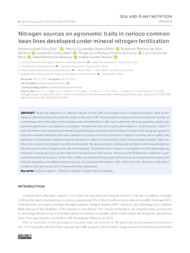Nitrogen sources on agronomic traits in carioca common bean lines developed under mineral nitrogen fertilization.
Nitrogen sources on agronomic traits in carioca common bean lines developed under mineral nitrogen fertilization.
Author(s): DIAS, P. A. S.; MELO, P. G. S.; FERREIRA, E. P. de B.; MELO, L. C.; SOUZA, T. L. P. O. de; FARIA, L. C. de; ALMEIDA, V. M. de; PEREIRA, H. S.
Summary: Despite the importance of symbiotic nitrogen fixation (SNF) as a nitrogen source for leguminous plants, there are few reports of common bean breeding programs aiming at efficiency in SNF. This study aimed to analyze the interaction between elite lines of common bean with carioca grains and the nitrogen source (mineral fertilizer or SNF), and to select lines with wide adaptability, stability, high agronomic performance, and superiority in nodulation. Nineteen lines with carioca grains were evaluated in 12 environments in Brazil. In each environment, one experiment with mineral nitrogen fertilization and another with Rhizobium inoculation were set up, and agronomic traits were evaluated. Nodulation traits were evaluated in two years at one out of five location. Analyses of variance and of stability were performed, and Spearman’s correlations and the coincidence of selection of the best lines in both N sources were estimated. There is an effect of the N source and of genetic variability for all the traits. The lines were higher yielding under fertilization with mineral fertilizer, but they were more resistant to lodging when they were inoculated. The line by N source interaction was significant for 100-seed weight and resistance to lodging, but it did not affect selection of the best lines in the N sources. Eleven out of the 19 lines had no difference in grain yields between the two N sources. The line CNFC 15086 is recommended for growing in both N sources since it presented the highest yield and high adaptability and stability under both sources. The genotypes BRS Sublime, CNFC 15010, and CNFC 15003 had a high relative nodulation index and can be used in crosses with higher yielding lines.
Publication year: 2024
Types of publication: Journal article
Unit: Embrapa Rice & Beans
Observation
Some of Embrapa's publications are published as ePub files. To read them, use or download one of the following free software options to your computer or mobile device. Android: Google Play Books; IOS: iBooks; Windows and Linux: Calibre.
Access other publications
Access the Agricultural Research Database (BDPA) to consult Embrapa's full library collection and records.
Visit Embrapa Bookstore to purchase books and other publications sold by Embrapa.

